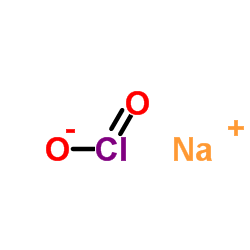亚氯酸钠
一般危化品

亚氯酸钠结构式
|
常用名 | 亚氯酸钠 | 英文名 | Sodium chlorite |
|---|---|---|---|---|
| CAS号 | 7758-19-2 | 分子量 | 90.442 | |
| 密度 | 1.28 g/cm3 (20ºC) | 沸点 | 112ºC | |
| 分子式 | ClNaO2 | 熔点 | 190 °C (dec.) | |
| MSDS | 中文版 美版 | 闪点 | N/A | |
| 符号 |





GHS03, GHS05, GHS06, GHS08, GHS09 |
信号词 | Danger |
|
Chemical isolation and characterization of different cellulose nanofibers from cotton stalks.
Carbohydr. Polym. 134 , 581-9, (2015) Recently, cellulose nanofibers (CNFs) have received wide attention in green nanomaterial technologies. Production of CNFs from agricultural residues has many economic and environmental advantages. In this study, four different CNFs were prepared from cotton s... |
|
|
The influence of lignin on steam pretreatment and mechanical pulping of poplar to achieve high sugar recovery and ease of enzymatic hydrolysis.
Bioresour. Technol. 199 , 135-41, (2015) With the goal of enhancing overall carbohydrate recovery and reducing enzyme loading refiner mechanical pulping and steam pretreatment (210°C, 5 min) were used to pretreat poplar wood chips. Neutral sulphonation post-treatment indicated that, although the lig... |
|
|
Fabricating electrospun cellulose nanofibre adsorbents for ion-exchange chromatography.
J. Chromatogr. A. 1376 , 74-83, (2015) Protein separation is an integral step in biopharmaceutical manufacture with diffusion-limited packed bed chromatography remaining the default choice for industry. Rapid bind-elute separation using convective mass transfer media offers advantages in productiv... |
|
|
Ionic liquid-mediated technology to produce cellulose nanocrystals directly from wood.
Carbohydr. Polym. 134 , 609-16, (2015) We report for the first time the direct extraction of cellulose nanocrystals (CNCs) from wood by means of a 1-ethyl-3-methylimidazolium acetate ([EMIM][OAc]) treatment. A native cellulosic product could be recovered in 44% yield with respect to wood cellulose... |
|
|
A comparative study on properties of micro and nanopapers produced from cellulose and cellulose nanofibres.
Carbohydr. Polym. 118 , 1-8, (2014) Cellulose nanocrystals (CNCs) and cellulose nanofibres (CNFs) were successfully extracted from cellulose obtained from maize stalk residues. A variety of techniques, such as Fourier transform infrared (FTIR) spectroscopy, scanning electron microscopy (SEM), X... |
|
|
Self-aggregated nanoparticles of carboxylic curdlan-deoxycholic acid conjugates as a carrier of doxorubicin.
Int. J. Biol. Macromol. 72 , 333-40, (2014) In this study, a new non-toxic, biodegradable, biocompatible and water-soluble carboxylic curdlan bearing the dissociable COOH group in 100% purity, which was prepared by 4-acetamido-TEMPO-mediated oxidation, was hydrophobically modified by deoxycholic acid (... |
|
|
Effect of the oxidation treatment on the production of cellulose nanofiber suspensions from Posidonia oceanica: The rheological aspect.
Carbohydr. Polym. 134 , 664-72, (2015) Different grades of cellulose nanofibrils (CNF) were prepared from Posidonia oceanica balls and leaves (POB and POL). Pretreatment using 2,2,6,6-tetramethylpiperidine-1-oxyl (TEMPO)-mediated oxidation was performed to facilitate the fibrillation during ultraf... |
|
|
Clinical efficacy of a chlorous acid preoperative skin antiseptic.
Am. J. Infect. Control 26(4) , 406-12, (1998) Among the ways to reduce the incidence of iatrogenic infectious disease is the use of efficacious preoperative antiseptics. Iodophors and chlorhexidines, the chief presurgical disinfectants today, have various problems with practicality. A new preoperative sk... |
|
|
Treatment with chlorous acid to inhibit spores of Alicyclobacillus acidoterrestris in aqueous suspension and on apples.
Lett. Appl. Microbiol. 51(2) , 164-9, (2010) To test the efficacy of a chemical (chlorous acid) for reducing the numbers of viable Alicyclobacillus acidoterrestris spores in laboratory media and on apples.Alicyclobacillus acidoterrestris spores in aqueous suspension and on apple surfaces of four differe... |
|
|
Treatment of genital herpes with chlorous acid releasing gel.
Genitourin. Med. 67(5) , 431, (1991)
|